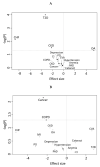Longitudinal Changes in Resting Metabolic Rates with Aging Are Accelerated by Diseases
- PMID: 33036360
- PMCID: PMC7600750
- DOI: 10.3390/nu12103061
Longitudinal Changes in Resting Metabolic Rates with Aging Are Accelerated by Diseases
Abstract
Resting metabolic rate (RMR) declines with aging and is related to changes in health status, but how specific health impairments impact basal metabolism over time has been largely unexplored. We analyzed the association of RMR with 15 common age-related chronic diseases for up to 13 years of follow-up in a population of 997 participants to the Baltimore Longitudinal Study of Aging. At each visit, participants underwent measurements of RMR by indirect calorimetry and body composition by DEXA. Linear regression models and linear mixed effect models were used to test cross-sectional and longitudinal associations of RMR and changes in disease status. Several diseases were associated with higher RMR at baseline. Independent of covariates, prevalent COPD and cancer, as well as incident diabetes, heart failure, and CKD were associated with a steeper decline in RMR over time. Chronic diseases seem to have a two-phase association with RMR. Initially, RMR may increase because of the high cost of resiliency homeostatic mechanisms. However, as the reserve capacity becomes exhausted, a catabolic cascade becomes unavoidable, resulting in loss of total and metabolically active mass and consequent RMR decline.
Keywords: aging; body composition; chronic diseases; resting metabolic rate.
Conflict of interest statement
The authors declare no conflict of interest.
Figures



References
-
- Kuo P.-L., Schrack J.A., Shardell M.D., Levine M., Moore A.Z., An Y., Elango P., Karikkineth A., Tanaka T., De Cabo R., et al. A roadmap to build a phenotypic metric of ageing: Insights from the Baltimore Longitudinal Study of Aging. J. Intern. Med. 2020;287:373–394. doi: 10.1111/joim.13024. - DOI - PMC - PubMed
MeSH terms
Grants and funding
LinkOut - more resources
Full Text Sources
Medical

